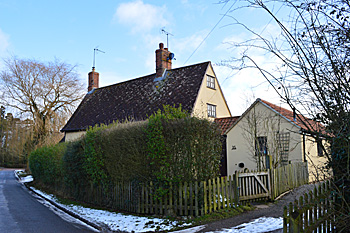35 Knotting Road Melchbourne

35 Knotting Road February 2014
35 Knotting Road was listed by English Heritage in August 1983 as Grade II, of special interest. It was probably always part of the Manor of Melchbourne and dates from the late 17th or early 18th century. It is timber-framed with rough-cast rendering, the south-western bay being in brick with rouh-cast render. The cottage comprises two storeys and attics beneath a modern tiled roof. There is a 19th century colour-washed brick extension to the north-east gable end and another lean-to extension at the south-west end.
The Rating and Valuation Act 1925 specified that every building and piece of land in the country was to be assessed to determine its rateable value. The valuer visiting the cottage found that, like most of the parish, it was owned by Lord Saint John of Bletsoe. It was divided into two dwellings. The tenant in the north-east portion was G Stanesly whilst the south-west portion was in occupation of H Clark. Both tenants worked for Lord Saint John and had identical accommodation: a living room, a kitchen and two bedrooms with a brick, weather-boarded and tiled washhouse and barn outside. G Stanesley's portion had an advertisement measuring 25 feet by 8 feet on the house's flank whilst H Clark's garden as over the road.
On 31st March 1951 Lord Saint John's estate in Melchbourne, Bletsoe and Riseley, known as the Melchbourne Estate and totalling 1,889 acres was put up for sale by auction in 81 lots [AD1147/32]. 34 and 35 Melchbourne, as they were known, formed Lot 8. Number 34, occupied by C Holmes, whose rent was £7/16/- per annum, had a sitting room, a living room, two bedrooms and a boxroom with a brick, weather-boarded and tiled washhouse and coal store. Number 35, in occupation of S Roberts, rent £8 per annum, comprised a living room, pantry and two bedrooms. Both dwellings had gardens and an earth closet. Water came from a standpipe on the main road.